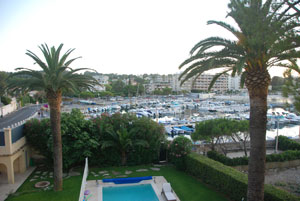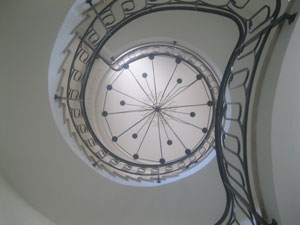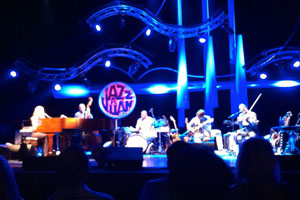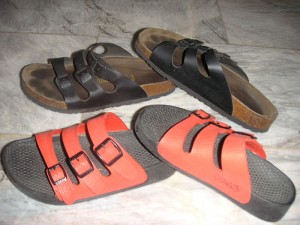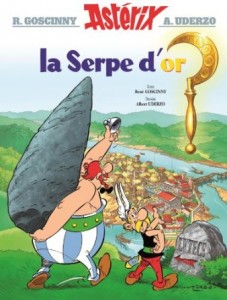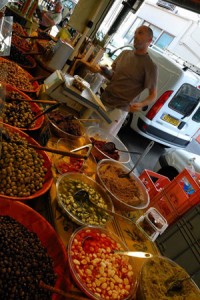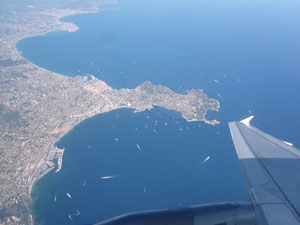It’s date night during the Côte d’Azur’s high season, and Philippe and I are counting on our lucky stars. It’s nearly 8pm, and having utterly failed to make a reservation, we take our chances. Navigating the narrow street that leads into Antibes’ Marché Provençal, Philippe squeezes the car to the side of the road, blocking three parked vehicles. He calls over the street to the guy in a black t-shirt who’s lingering there, near the doorway of his restaurant.
Yes, there’s one remaining table for two tonight in his small restaurant. The ruddy chef with spiky chestnut hair and trimmed stubble takes our car keys. He’s busy waving off folks in a car that’s double-parked behind us. On closer inspection, I’m guessing they must be his parents.

Philippe and I are the first to arrive at L’Armoise tonight. A sole, ponytailed waitress, one we’ve not seen before, greets us cheerfully and offers us a choice of table. We seat ourselves just inside the doorway, sidled up against an open window cut into what look like hand-plastered white walls. But it’s the ceiling that gives this room its rustic charm, the white plaster cut by long ribbons of dark wooden beams. Philippe and I take a gander at tonight’s menu, which is handwritten on a chalkboard fixed to the back wall, and again we admire the poetry of a French menu:
POUR COMMENCER (TO BEGIN)
- Velouté de courgettes pays, radis roses, concombre, morceaux de chèvre frais (creamy zucchini soup with a scattering of radish, cucumber and fresh goat cheese)
- Risotto à la pulpe de fenouil, poulpe de roche, haricots verts, pétales de gingembre (risotto with fennel, rock octopus, green beans and flakes of fresh ginger)
POUR SUIVRE (TO CONTINUE)
- Selon la pêche, aubergines, pois gourmands, sucrine, fine purée d’épinards (daily fish, eggplant, peas, baby lettuce and spinach purée)
- Poitrine de pintade fermière, écrasé de pommes de terre citron, petits pois, artichauts violets (breast of guinea fowl, lemon mashed potatoes, peas and purple artichokes)
POUR FINIR (TO FINISH)
- Douceur de fruits rouges, éclats de nougatine, glace pistache, jus de framboises (sweet of red fruits, nougatine slivers, pistachio ice cream and raspberry juice)
- Nectarine jaune pochée dans un sirop verviene, mûres, meringue, glace vanilla (yellow nectarine poached in a vervain sirop (the leaf is often used for herbal tea here), blackberries, meringue and vanilla ice cream)
We decide to try everything. Meanwhile the muscular, spiky-haired chef has dealt with our car, easing it back into his parents’ former space that blocks another set of three legally parked vehicles.

You’d hardly expect such multi-tasking from a hardworking chef – just as we hardly presumed to snag a table at his restaurant tonight. But Laurent Parrinello is becoming better known by the week. The New York Times mentioned him in a best-of-the-Riviera article placed just before last summer’s high season. The latest piece of literature was a short paragraph, photo and all, that appeared in an article about Antibes’ top restaurants in Le Figaro Magazine just a couple weeks earlier – though, it should be said, I didn’t see the article until just after our dinner this night. From this national magazine I would learn that Parrinello formerly worked down the road at Restaurant Eden-Roc (situated within the five-star celebrity magnet, the Hôtel du Cap). I also would confirm something I already suspected about one of my favourite chefs: He picks his way through the neighbouring Marché Provençal each morning to unearth the day’s best produce.
These days the doorway to L’Armoise is decorated with various important stickers, like the big red dot proclaiming “2013 Michelin Guide”. But Philippe and I stumbled on the pint-sized restaurant years ago. It had been one of three intriguing nooks along that same narrow track leading up to the Marché Provençal, and over the years this one has remained our favourite.
The waitress comes to take our order. She’s the perfect girl-next-door, cheerful and efficient with a slender frame, flawless complexion and glossy, dark hair pulled back into a simple ponytail. Her attire follows this script. The girl-next-door wears a crisp white shirt with puffy, short sleeves, and a silver heart pendant dangles around her neck.
Other neatly dressed diners, mostly French-speaking couples, have begun to filter into the restaurant. A long mirror runs horizontally along one wall, presumably an attempt to enlarge the room. Beside it stands a tall vase of long-stemmed, cream callas. Philippe and I count the number of seats in the restaurant – probably the fifth time we’ve done this exercise over the years – and still we cannot believe it’s only 20.
Another couple stops to read the menu posted outside L’Armoise’s front door. The waitress politely turns them away. The restaurant is full tonight, she says.
Philippe and my conversation fixes onto on the subject we entertain pretty much every time we dine chez L’Armoise. How can this restaurant survive on a nightly clientele of 20? True, the chef does have certain positives from a business perspective. The limited menu means limited wastage. A minimal employee roster brings fewer French social charges and the related headaches. And the restaurant’s proximity to the Marché Provençal surely eases its supply chain.
But there’s an overwhelming con: 20 meals a day – au maximum – because just like in most restaurants in France, the brains behind L’Armoise have absolutely no urge to flip tables! Making matters more fragile are rising raw material costs (staff included) and a general cost-trimming by the dining public. Also hovering is the whole “fait maison” effort circulating within France at the moment. In the future restaurants may be required to identify which dishes are “homemade” from fresh ingredients – with glaring gaps remaining beside those menu items that are brought in. But then, I’m guessing L’Armoise is already a fait maison sort of place.
As we dip into a generous amuse-bouche of polenta and salad greens, Philippe and I settle into familiar conversational territory. The French, generally speaking, have a total incomprehension of how business works. Okay, that’s too strong. But the way they think about business is entirely different to the way most Anglophones do. The French work to live, not the other way around. The idea is a completely laudable one, for sure, but taken beyond reason you can find the mentality is not so productive.
Like Olivier, I say.
Philippe understands entirely. Our friend is a highly qualified dentiste – a dental surgeon, to be exact – with his own cabinet equipped in the latest and highest quality machinery. But Olivier hardly uses the place as much as you’d expect. He reserves Mondays for himself – to study, of all things, more dentistry. It’s part of his overarching aim of a well-proportioned lifestyle. Why buy a house, he wonders, when an apartment will do? Life is about quality, not quantity.
Philippe and I both get the lifestyle-choice argument, honestly we do. It’s just that there are far more Oliviers in this part of the world than we outsiders would expect.
And there’s that toy store in Cannes, Philippe says.
Absolutely. We tracked down En Sortant de l’École, a beautiful, old-fashioned toy store in the main shopping corridors of Cannes a while back. But at 10:45 a.m., the shop remained closed, 45 minutes after it was due to open. We returned at midday and found a woman just organizing her till. It had been a long night, she said. She’d decided to sleep in. Surely the explanation involved some sort of French shrug.
As Philippe and I wait for our starters, another few enquirers linger before the menu outside L’Armoise, but the waitress turns them all away. Meanwhile a small French-speaking group has arrived at the table behind me, and beside us is a table of two couples, presumably parents with their child and spouse. The younger woman is visibly pregnant. They share a Scandinavian-sounding dialect but navigate the menu with the ponytailed waitress in halting English.
Philippe remembers a joke a local friend told him earlier this summer. It’s a new one to me. You know what they call French people? he asks. Des Italiens malheureux! Unhappy Italians!
Unhappy or not, you cannot deny that the French know how to cook. I’m spoiled by my risotto – I couldn’t resist the tangy ginger taste combination – and Philippe is hardly malheureux about his creamy zucchini soup. Behind my husband I watch Parrinello through an open window leading directly into his kitchen. The restaurant’s engine is all aluminum and high-tech, a sharp contrast to the rustic feel of the dining area. Sometimes Parrinello’s back is turned as he hovers beneath an aluminium stove hood. Other times he faces into the restaurant, his concentration evident as he embellishes plates beneath the serving counter. A framed photo hangs on the wall of this wide serving nook; a bright red, hand-cut star occupies its lower left corner. From inside the frame a toddler girl, all innocent-eyed, gazes out into the restaurant.
What is it about French morosité, Philippe and I wonder amid this most agreeable setting, that gets such constant airing? Our affable waitress aside, why is the typical French reaction to râler (to moan)? What keeps this lot from being more joyful, more pull-up-your-bootstraps-and-get-to-work like the Americans?
I’m reminded of something my witty French instructor said last year at Alliance Française in Toronto. Joie de vivre, Jean-François said, is an Anglicism. The French don’t use the phrase. The concept of joie (joy), he said, is a bit too jolly for the French. A bit too much like Père Noël (Santa Claus).
Philippe and my utensils stray onto each other’s plates as we warm to our evolving theme of the French work ethic. The work-to-live ideology is a strong force here from the get-go. But there’s another pivotal factor that pushes the idea even further into the everyday mindset: taxes, the French Government’s own disincentive to work.
Stories flood into our conversation, one recollection spurring another. We know people – our favourite cheese seller and our family doctor, to name two – who cut back their hours in order to pay fewer taxes. The goal is to earn enough without earning too terribly much.
But working fewer hours hardly means people share their load either. The fromager won’t hire a helper in spite of a sometime 30-minute queue that snakes along his cheese stall in the jammed market aisles. He’d have to pay too much tax. Social charges paid directly from employer to the government, we know, are roughly equivalent to the employee’s very paycheque. Hiring someone, in other words, costs about twice the quoted salary. And thanks again to more bureaucracy, it’s impossible to get rid of employees for poor performance or even a downturn in business.
The simple answer? Do the work yourself – enough, but not too much.
And now housekeepers are covered in this tax category, I remind Philippe. A local banker friend mentioned this one earlier in the summer. Employees inside the home – housekeepers and the like – used to be afforded a 50% social tax rate paid by their employers. Now they, too, cost a second salary. But, our banker friend told us with a smile, the government’s take on social tax contributions from home employees actually fell in the last period by 8%. She asked us, do you really think people have suddenly fired their housekeepers?
The ponytailed waitress delivers our mains, describing Philippe’s guinea fowl and my white fish with appropriate flourish before darting off to another table. Parrinello’s culinary flair continues. And I’m thankful, in a female sort of way, that this time my plate is the less ample one.
Philippe recalls a recent trip to buy a swimsuit in neighbouring Juan-les-Pins. Numbers were down again, the grey-haired shop owner said. His wife owns a women’s store two doors down and was in the same business boat. The couple work their neighbouring stores with little rest in the high season. Once they hired someone to help out, the man told Philippe, but she never showed up, so now they simply use their teenage daughter. And then the couple closes their doors at the end of October. After all, the man said, who buys swimsuits in the wintertime?
The storeowner’s conversation shifted all-too-naturally to taxes. We find it’s a hot topic this year – and unsurprisingly so. Everyone wants to blow off steam, especially here in the Côte d’Azur, as these folks never voted to put the current government in office. Local friends have confessed to their embarrassment for the nation.
Last year, two weeks before the end of his season, the husband of this Juan-les-Pins shop-owning couple put a sign in his front window advertising a promotion. Shortly an agent from the fraud department – basically the French IRS – strode through the door. Promotions weren’t allowed during those weeks in October, she said. They were not part of the official, French sale period. For this crime of putting 50 end-of-season bathing suits on promotion, the storeowner was slapped with a EUR 2,000 fine.
Dinner at L’Armoise always seems to spur on this sort of conversation. It’s as if, for all the years Philippe and I have dined here, we think that one day we’ll crack the mystery of how this place stays afloat. But we never seem to get anywhere. Each year we return to Parrinello, toiling away on the other side of his serving nook, his meals as top-notch as ever.
Our mains have been cleared by this time, and what with the amuse-bouche, some bread, the starters and the mains, Philippe and I only can manage a shared dessert. We explain our predicament to the ever-engaging waitress and opt for the fantasy of red fruits.
At the same time we continue in our conversational vein, insisting that the go-slow work ethic is somehow intrinsic to the French psyche. Some intangible motivation allows businesses to leave sales on the table, even if the rationale has nothing to do with the work-to-live mentality or higher taxes.
Like choquettes, I say.
Just like choquettes, Philippe says. He knows exactly what I mean. These airy bites of pastry sprinkled with pearls of white sugar have been our longstanding touchstone for the utter lack of French business initiative. Our local boulangerie at l’Ilette makes the best choquettes on the planet – moreish and sweet, but never ever doughy or greasy. And yet if you show up at the boulangerie too late in the day, you’ll find the stock of choquettes was gone hours ago. Or if you visit on the wrong days of the week, you’ll find the boulangerie doesn’t make choquettes those days. You’d think, given that the shop is open to queues of customers all day long, seven days a week . . . but that just makes too much business sense.
Sabrina, our French nanny, has her own complaints about the business mentality of her native land, too – but then she has lived in North America for several years. She has a new apartment in Toulon and wants to fix up the kitchen. At the end of July, she visited Ikea, the famous Swedish superstore that fits homes literally the world over. The attendant in this French Ikea outlet was happy to take Sabrina’s order, but she warned that nothing would happen until September – a whole month-and-a-bit later. August was August, she explained.
“C’est un peu bizarre,” Sabrina said to me. Then she shrugged her shoulders in acceptance. “C’est la France.”
When the genial waitress arrives to clear our dessert plate, Philippe and I can hold back no longer. After complimenting her (again) on the meal, we find out that she joined L’Armoise in March this year. She came south from Burgundy.
She may be a fairly new kid on the block, but business in this diminutive restaurant continues like we always remember it, we say. Why do you keep turning customers away? we ask. Wouldn’t you want to turn any table that you can – to get more customers in? We’re evidently thinking about our own table, which is coming free only 30-minute after the latest enquiry.
Non, the girl-next-door says. We do 20 meals a night, she insists, and we do them correctement.
Enough is enough – especially in a restaurant that already abides by the time-consuming, fait maison criteria. Anyway, she says, the chef doesn’t want to hire other people – except maybe to wash the dishes.
It all makes perfect French sense, but we’re feeling none the wiser. Before making a move from our table-for-the-night, Philippe and I formulate the best question we can ask Parrinello directly on our way out. He’s still preparing orders on the other side of the high countertop, the photograph of the toddler girl keeping watch over his diners.
Philippe manages to launch this question into the kitchen. After praising the chef’s continued culinary success, Philippe asks Parrinello why he doesn’t expand his shop.
I like being a chef, he says. And I don’t want any more employees.
The obvious answer – and yet, it’s only so obvious in France.
Parinello takes a momentary break from his work. Moisture dots his hairline even now that the day’s abundant heat has dissipated.
I went to the accountant two days ago, he says, his hands pressed firmly into the counter to hold his weight. The guy told me j’ai perdu six ans de ma vie – that I lost six years of my life. I have less money now than I started out with, he says.
Put succinctly, the government eats all his profits.
I’ve tried, he continues, and I love what I do, but it’s not worth it. The rising chef vows that he’d sell his business and leave France in a minute – if that offer only was available.
All of which, with some neat tagline, would have made a perfectly good-if-sobering end to this post. But it gets better. Last week, two weeks after our gorgeous meal at L’Armoise, Philippe and I again find ourselves walking that narrow strip of road leading up to Antibes’ Marché Provençal. As we near L’Armoise, who’s up ahead but chef Parrinello, just nipping out for a smoke.
It was in this interim two-week period that we unearthed Parrinello’s latest plaudits in Le Figaro Magazine. Now, seeing him again, Philippe suddenly strides across the road toward the loitering chef, who shuffles around outside his open kitchen window.
Hey, my husband calls, congratulations on the Figaro mention! It’s really good news.
Parrinello looks up. Ah, it’s not so great, he says. The revered chef is distracted, surly even. The word morosité springs to mind.
What’s not great? Philippe asks, surprised. You’re named up there with all the top restaurants in Antibes!
Something flickers now in Parrinello’s brain and he softens. The cigarette might be calming his nerves or perhaps, now that I’ve caught up with Philippe, Parrinello recognizes us as his fans. Or maybe the chef feels he already has fulfilled his French duty to râler as the initial reaction to most anything, from burdensome request to the highest of praise.
Parrinello gives the slightest nod of his head. Well, yeah, he says of this magazine recognition that we’re insisting is so fortuitous. Yeah, he says, I guess it’s okay.






